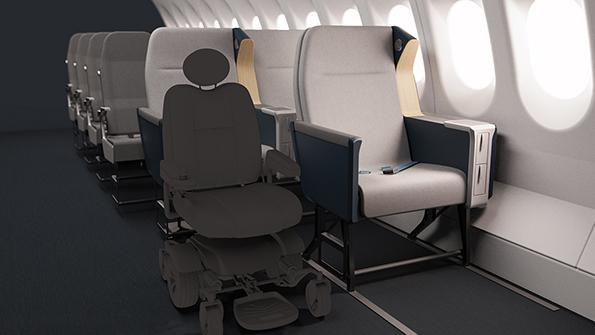
Airline passengers with reduced mobility could soon remain in their own wheelchairs in flight if some in-development products gain regulatory approval.
“Power wheelchair users typically have thoracic support built into the chair element, giving them medical support that an aircraft passenger seat cannot offer,” says Christopher Wood, a UK-based aviation accessibility consultant and founder of Flying Disabled, an organization that advocates for mobility-challenged airline passengers. “Ultimately, the loss of this support in a passenger seat negates much of the safety aspect of the passenger seat itself.”
Flying Disabled is part of Air4All, a consortium that includes design company PriestmanGoode and SWS Certification Services, a certification and regulatory consultancy focusing on fixed wing and rotorcraft interiors. Simply put, Air4All would allow passengers to remain in their own wheelchairs in flight: Its specially designed front-row seat equipped with a removable back and a flip-up seat bottom would enable the seat to interface with the wheelchair.
The airline seats and wheelchairs “facilitate an installation and attachment system,” allowing them to be securely installed in the aircraft cabin, says PriestmanGoode Chairman Paul Priestman. Collectively, the seat, the wheelchair attachment mechanism, the guiding system and the latch attached to the wheelchair are included under a patent held by the consortium.
The complete aircraft seat will be certified and approved through the normal aircraft seat approvals route—either a technical standard order (TSO) or an aircraft-level major change via a supplemental type certificate, says Nigel Smith, director of SWS Certification.
“The means of attaching the wheelchair to the aircraft will be a discrete system, interfacing—but not part of—the seat structure and certified as an aircraft-level structural modification for ‘retention of items of mass,’” Smith says. “The wheelchair will require the development of an aircraft standard along the same lines as current aircraft-approved automotive child seats, which is the more challenging side of the overall system certification and approvals.”

Smith adds that any cabin modifications “as currently envisioned” would involve replacement of an existing seat with the new seat and installation of the wheelchair locking system. At the same time, some additional or repositioned placards might be required.
A different approach to aircraft seating for passengers with reduced mobility is being pursued by Molon Labe Seating, a Denver-based airline seat vendor, working in concert with an undisclosed air carrier. Dubbed the “Freedom Seat,” the project, in development since 2020, has reached the prototype stage. According to Molon Labe CEO Hank Scott, the prototype is an outgrowth of the OEM’s side-slip seat system, a triple economy-class seating assembly designed to enable faster passenger loading and unloading.
The Freedom Seat, Scott explains, consists of a double-seat system in which the seat on the aisle detaches from the cabin floor and is stacked on the adjacent seat, leaving the vacated space for a wheelchair to lock in place. “Passengers using the [stacked] Freedom Seat will notice no difference in comfort or feel,” he notes. “For the wheelchair docking system, we are collaborating with Q’Straint as well as Flying Disabled.”
Due to the width of the two seats, Scott says they would be installed at either the front or rear row of the cabin, on both sides of the aisle. At the front of the cabin, the wheelchair passenger would have direct boarding bridge access, he points out.
Scott expects certification of the Freedom Seat to be relatively straightforward, since its design has passed all the TSO authorization-required crash testing, which Molon Labe performed in-house. It worked with the National Institute for Aviation Research at Wichita State University, which carried out the digital dynamic modeling and analysis. “That pretty much tells us how the seat will perform in a real test and allows us to modify the design to be light and strong,” Scott explains.
He cautions, however, that other issues need to be addressed for the Freedom Seat: “Would a reinforced floor modification be required? Also, the FAA would view the wheelchair—once onboard the aircraft—as part of the airframe and be concerned about the risk of hurting a passenger or interfering with passenger evacuation in the event of an accident.” In addition, since powered wheelchairs are not made to a standard size, Scott says: “Each manufacturer will have to come up with an FAA-approved design.”





